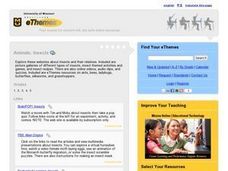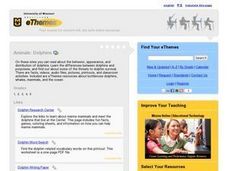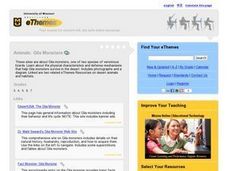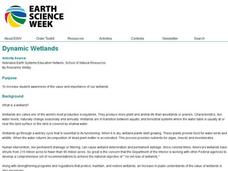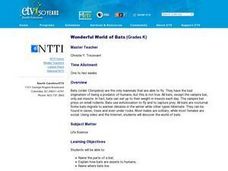Curated OER
Turtle Legends
Students listen to the legend, Thirteen Moons on Turtle's Back. They create a new moon for the calendar based on this natural part of everyday life in the seasons. They illustrate it under the story using water color paints.
Curated OER
Animals of Madagascar
Students are each assigned an animal from Madagascar. They research their animal and design a picture book about their animal. Students design a cover page, back page, bibliography page and the title page. Their book will contain...
Curated OER
Animals: Insects
Students use the Internet to examine insects and their relatives. They participate in online games and discover insect recipes.
Curated OER
Animals: Dolphins
Students use the internet to discover information about dolphins. They examine their behavior, appearance and distribution of dolphins.
Curated OER
Water
Students create a water filter according to given criteria. I this chemistry lesson, students evaluate the importance of water in their lives. They develop a book or brochure on the water treatment process.
Curated OER
Cellular Respiration and Photosynthesis
In this cellular respiration and photosynthesis worksheet, students read through the presented material and draw an illustration of the production of ATP. Students answer several short answer questions about the production of ATP,...
Curated OER
Island Animals
Students explore the concepts of endangered animals and conservation. In this animal conservation lesson, students complete activities to investigate the endangered animals of the US Virgin Islands. Students complete multiple worksheets...
Curated OER
Animals: Gila Monsters
Students research sites about Gila monsters. They explore the physical characteristics and defense mechanisms that help Gila monsters survive in the desert. Includes photographs and a diagram.
Curated OER
Cicada Invasion
Students consider how some animals, periodical cicadas, survive well in a particular environment due to the species' life cycle.
Curated OER
Bird Stories: Fact or Fiction
Students evaluate/distinguish scientific fact from fiction. They discuss similarities and differences in the life cycles of various birds. Student use the Internet as a research tool.
Curated OER
An Introduction to Brine Shrimp
Second graders engage in a lesson that seeks to discover information about Brine Shrimp. They conduct research using a variety of print and electronic resources. Students study the type of environment the shrimp need and read about the...
Curated OER
Photomosaic Pixel Composite
Learners research the habitat, diet, life cycle, and characteristics of an animal, and create a Japanese scroll painting of their animal. Using scanned images of animals they have painted, they create a composite mosaic using PowerPoint.
Curated OER
Salmon Run
Students examine the life cycle of the Pacific salmon and the impact of humans on salmon migration. They watch a Powerpoint presentation, trace migration routes on satellite imagery, and complete mock calculations of salmon energy...
Curated OER
Caterpillar Habit
Students watch a caterpillar change and become a butterfly. In this lesson about the life cycle of a caterpillar and a butterfly, students prepare and maintain the habitat of the caterpillar. Students observe the stages of the...
Curated OER
Hide In Plain Sight
Students view video clips and use the Internet to look for hidden animals. They then use the Internet to print out animal shapes and color them. They create environments on construction paper in which their animals can hide.
Curated OER
Dynamic Wetlands
Students construct and observe a model of two different types of wetlands. In this wetlands lesson, students create a model of a wetland with constant drainage and a wetland that maintains a well-saturated soil. Students observe and...
Curated OER
Wonderful World of Bats
Students create a book about bats. They write a letter to a scientist containing questions about bats. They compare the socialization of bats to humans; compare the needs of bats to humans and other animals.
Curated OER
Ourselves
Students identify the main parts of the human body. They point to various parts of their own body, cut out pictures of humans and animals and sort them into the two categories, discuss the differences between animals and humans, and...
Curated OER
Make it a habitat
Students consider the adaptation of life forms through natural selection to fill various niches and accommodate changing environmental conditions. They select an ecosystem and conduct research to provide as much detailed information as...
Curated OER
Interdependence and Adaptation
Fifth graders construct a food web to illustrate how animals and plants are interdependent. In this interdependence lesson, 5th graders identify how consumers, producers, herbivores, carnivores and predators are related in a habitat....
Curated OER
How Plants Help Us Breathe
Third graders discuss how humans breathe and how plants help us to stay alive. In groups, they identify and label the different parts of plants and describe their functions. They compare and contrast the ways plants and animals breathe...
Curated OER
What's Hatching in Kindergarten?
Students identify oviparous animals. They brainstorm a list of animals that lay eggs, read "Chickens Aren't The Only Ones" by Ruth Heller and then add to the list. Students complete a booklet that shows an egg and an oviparous animal.
Curated OER
Hatching Brine shrimp
Second graders investigate the life cycle using brine shrimp as an example. They conduct observations by watching the shrimp hatch out of cysts. Students design simple experiment to structure an observation. The experiment is approved...
Curated OER
Tadpoles and Frogs
In this problem solving activity, students read a word problem about tadpoles and frogs and then complete three questions about the frogs life cycle changes.




